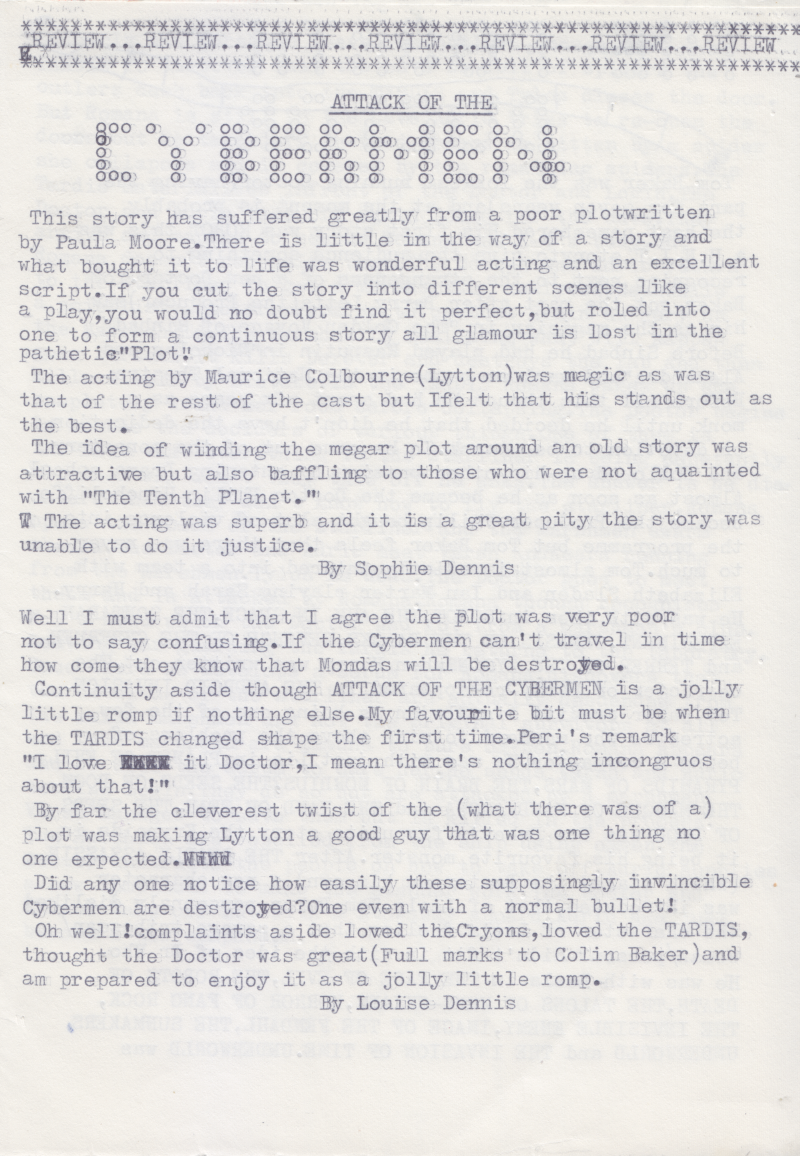The Faceless Ones
Tame Layman vetoed The Faceless Ones when we did the Randomiser for reasons that remain obscure to me. I had vaguely planned to revisit the question once we got to the end but by that point the animation had been announced so it seemed better to wait.
I had mentally class The Faceless Ones as a "weird early Troughton" which placed it in the same category as The Underwater Menace and The Macra Terror but actually this is a very different beast. It is much closer in feel to the more realistic Avengers-like atmosphere of The War Machines. Much is made of the Gatwick setting - at least in the first episode which we watched live-action and Tame Layman was impressed enough to comment on the location work. While later episodes do seem to spend an awful lot of time with people sitting outside the Chameleon Tours office, it's only in retrospect that that becomes obvious and, at least viewed an episode at a time, the story progresses at a reasonable pace.
I was genuinely amazed and impressed at the shots of an airplane landing inside a spaceship. I mean, I've no idea what this would have looked like with 1960s model-work but the animation looked great and really added to the feel of ambitious scale to the story. Tame Layman really enjoyed the way the story unfolded. Again, in retrospect, there's quite a lot of running around to no great purpose, but there are several clever ideas along the way, particularly in the later episodes, and its nice to have a resolution in which the antagonists are sent away with slapped wrists rather than being destroyed.
I was a bit disappointed in Pauline Collins' Samantha Briggs. As a character being tried out as a potential companion she ultimately seemed rather superfluous to the action. I'd expected her to be more obviously proactive somehow. However the story did effortlessly pass the Bechdel test partly as a result though, in fact, there are no less than three other one-off female characters in the story, which is more than can be said for many 1960s episodes.
I'm a little surprised this story isn't spoken of more often and more highly in Doctor Who circles. Obviously the fact only two episodes exist mitigates against it, but its a lot of fun as well as being an interesting look at the kind of story the early Troughton years were trying to tell, and the show's initial attempts at telling contemporary tales, before it got side-tracked into endless bases under siege.
I had mentally class The Faceless Ones as a "weird early Troughton" which placed it in the same category as The Underwater Menace and The Macra Terror but actually this is a very different beast. It is much closer in feel to the more realistic Avengers-like atmosphere of The War Machines. Much is made of the Gatwick setting - at least in the first episode which we watched live-action and Tame Layman was impressed enough to comment on the location work. While later episodes do seem to spend an awful lot of time with people sitting outside the Chameleon Tours office, it's only in retrospect that that becomes obvious and, at least viewed an episode at a time, the story progresses at a reasonable pace.
I was genuinely amazed and impressed at the shots of an airplane landing inside a spaceship. I mean, I've no idea what this would have looked like with 1960s model-work but the animation looked great and really added to the feel of ambitious scale to the story. Tame Layman really enjoyed the way the story unfolded. Again, in retrospect, there's quite a lot of running around to no great purpose, but there are several clever ideas along the way, particularly in the later episodes, and its nice to have a resolution in which the antagonists are sent away with slapped wrists rather than being destroyed.
I was a bit disappointed in Pauline Collins' Samantha Briggs. As a character being tried out as a potential companion she ultimately seemed rather superfluous to the action. I'd expected her to be more obviously proactive somehow. However the story did effortlessly pass the Bechdel test partly as a result though, in fact, there are no less than three other one-off female characters in the story, which is more than can be said for many 1960s episodes.
I'm a little surprised this story isn't spoken of more often and more highly in Doctor Who circles. Obviously the fact only two episodes exist mitigates against it, but its a lot of fun as well as being an interesting look at the kind of story the early Troughton years were trying to tell, and the show's initial attempts at telling contemporary tales, before it got side-tracked into endless bases under siege.
